Virtual colonoscopy improves colon polyp detection
Virtual colonoscopy computer-aided detection (CAD) helps radiologists detect polyps when the growths are hidden, or partially hidden, in pools of fluid in the colon. That finding, published in a study reported in the January 2005 issue of the American Journal of Roentgenology, is a prominent step forward in the evolution of colon CAD.
A special algorithm (a mathematical rule or procedure executed on a computer) represents the core of the CAD system used in the study. "With virtual colonoscopy, additional air is put in the colon via a rectal tube. The colon is a floppy structure that must be inflated to view the polyps," said the study's lead researcher Dr. Ron Summers, CC Diagnostic Radiology Department. "With the first version of the CAD algorithm you could see polyps in the air-filled parts. We made modifications to the algorithm so that the air- and fluid-filled parts of the colon could be viewed. This leaves no invisible or blind parts of the colon."
Several years ago Summers found that a computer program could discover polyps in the colon and he worked to improve the CAD software. Currently, CAD cannot be used in the clinical setting as the primary reader of colonoscopy results. All results must by interpreted by radiologists. "The CAD software is not intended to replace human readers of colonoscopy results." said Summers. "But, it may boost the efficiency and check the accuracy of the human reader."
Summers collaborated with researchers at the National Naval Medical Center (NNMC), who provided him with a dataset of 1,100 patients who had undergone colonoscopy.
"Each of the 1,100 patients had taken a contrast agent. Without the contrast agent pools of water, found normally in the colon, obscure the polyps. "This is a new challenge for computer-aided detection of polyps on CT colonography because most CAD is designed to find polyps only in the air-filled colon," said Summers.
"This CAD algorithm can find polyps surrounded by air, fluid or both," said Summers. He likens the algorithm to a marine porpoise that "jumps" from air to fluid present in the colon and back again until all portions of the colon are identified.
For the study, researchers analyzed a subset of 17 of the 1,100 NNMC patients. Each subject had at least one proven colon polyp that was submerged in contrast-enhanced fluid. The CAD system was able to find 19 of the 22 polyps that had been detected by human readers.
"As far as I know, we are the first to publish such a CAD algorithm for use in colon polyp detection that deals with the fluid problem," said Summers.
"With further development colon CAD polyp detection will aid in earlier diagnosis of this disease in the general population," he said. The research team is planning a larger study using the same approach for all of the 1,100 patients. They will try to improve the sensitivity and specificity of the algorithm.
The study team included researchers from the NNMC and the Uniformed Services University of the Health Sciences in Bethesda; the Walter Reed Army Medical Center in Washington, D.C.; and the Naval Medical Center, San Diego.
The published study is in the online American Journal of Roentgenology, http://www.ajronline.org/. Under Quick Search enter January 2005, Vol. 184:1, pp. 105-108.
Back to Top
New patient gateway
|
|
|
Construction is almost complete on a new, friendlier NIH entrance for patients and visitors. It's located at the intersection of West Cedar Lane and West Drive, directly north of the main entrance of the Mark O. Hatfield Clinical Research Center.
"Our patients are important and we want their experiences here to be smooth from the start," said Dr. John I. Gallin, CC director. "The new entrance will simplify and ease access to NIH. Clinical Center hospitality staff stationed there will provide directions, answer questions and generally help ease the transition onto campus."
The facility itself features a 780-square-foot visitor processing center, two vehicle inspection lanes and a security booth.
|
Back to Top
NIH Blood Bank offers the "ultimate experience"
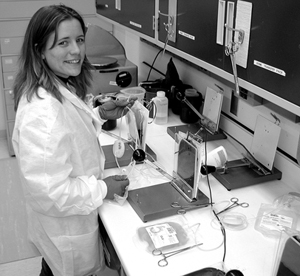
|
Medical technologist Heather Grose conducts the first phase of blood separation. Blood
is broken down into red blood cells, liquid plasma, which will become fresh frozen, and
"buffy coat," the white cells used for research.
|
Donating blood or platelets at the NIH Blood Bank has become a regular activity for many on campus. Researchers, patient care staff and blood bank facilitators view the generosity of NIH personnel at all levels as maintaining the vital link between the CC's clinical research mission and saving the lives of patients treated at the NIH hospital.
The Department of Transfusion Medicine, which includes the NIH Blood Bank, has established a goal of ensuring that every donor has the "ultimate blood donation experience."
The Blood Bank has extended its hours of operation and now is open weekdays 7:30 a.m. to 5:30 p.m. Reserved and convenient parking, overseen by an attendant, is available for donors on Convent Drive, just a few yards south of the Center Drive security checkpoint. The NIH Blood Bank is on the first floor of the Clinical Center, Room 1C713.
In support of the altruism of blood donors, the NIH administrative policies grant two hours of administrative leave, with supervisor's approval, on the day of donation. This allows for enough time to donate blood and then still have time to rest and enjoy the goodies at the Blood Bank's canteen. Platelet donations usually last 90 minutes, allowing time to take in a movie while donating. Whole blood donation takes between 45-60 minutes.
An experienced staff of medical professionals tries to ensure a successful and pleasant donation experience and are working hard to earn your trust and confidence. It's their hope to create a desire in all blood donors to return and become part of a life-saving team not once but several times each year.
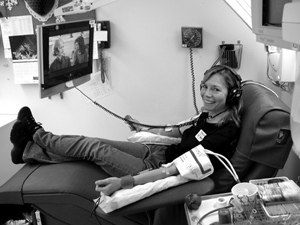
|
Cindi Marshall catches up on movies while she donates platelets.
|
"I've been coming every month for almost two years," said donor Cindi Marshall, a FedEx employee. Lying on a comfortable recliner, she donates platelets and catches up on one of the NIH Blood Bank's extensive library of DVDs. "It's something I feel good about doing because it helps others in so many different ways. Plus, I can catch up on some of the movies I missed."
Donor eligibility requirements protect the health and safety of the donor as well as the patient who will ultimately receive the transfusion of blood or platelets. To donate blood for transfusion to another person, you must be in good health, be at least 17 years old, weigh more than 110 pounds and not have donated blood in the last 56 days. Your personal health and travel history will be discussed by the screening nurse along with the results of a mini-physical during which temperature, pulse, blood pressure and blood iron content (hemoglobin) are measured prior to donation. This basic and regular health monitoring of blood donors is a valued added benefit to the experience. Call the Blood Bank for an assessment or questions about eligibility.
You'll feel special as an NIH blood donor. And you'll feel even better knowing that you may have saved a life. It is difficult for one person alone to solve the world's problems, but it's easy to save a life with a single blood donation.
For more information, go online, www.cc.nih.gov/dtm
Back to Top
News Briefs
Functional Genomics conference set for April
The Third Symposium on the Functional Genomics of Critical Illness and Injury will be held April 21-22 at the Natcher Conference Center . The 2005 Symposium will provide opportunities for commu-nication among experts in critical care medicine disciplines and the field of functional genomics. The Clinical Center 's Critical Care Medicine Department is a conference sponsor.
This year's conference will focus on genomic, transcriptomic and metabolomic analysis; host-pathogen responses; and the ethi-cal, legal and societal implications of genomic technologies.
The event will showcase the latest research findings, facilitate the exchange of information on state-of-the-art methodologies, and highlight current and future challenges. There will be plenary and poster sessions with a new interactive format to facilitate informal discussions and the development of new collaborations.
For more information, call 410-377-0110 or go online, http://www.strategicresults.com/fg3
Nurses Week 2005
Plans are in the works for the 2005 National Nurses Week. “Nurses: Many Roles, One Profession,” is the nationwide theme for this year's celebration, a focus that strongly resonates with the Clinical Center nursing team members no matter what role they fulfill clinical research nurse, clinical nurse specialist, clinical manager, clinical educator, research coordinator, nurse practitioner or nurse manager.
National Nurses Week begins each year on May 6 and ends on May 12, Florence Nightingale's birthday. The week honors the dedication, commitment and tireless effort of the nation's nursing professionals. The Clinical Center Nursing and Patient Care Services Recognition and Retention Committee is planning this year's celebration, which will include a variety of special activities.
Mark your calendar for May 6-12 to salute nursing at NIH.
Programs for new nurses
The Clinical Center Department of Nursing and Patient Care Services is accepting applications through April 6 for three programs for new nursing graduates. All are designed to help give new nurses the confidence and experience to launch a professional nursing career in a clinical specialty. Programs are:
- Oncology Nurse Fellowship
- Medical-Surgical Nurse Internship
- Pediatric Nurse Internship
For more information, contact the CC Nurse Recruiter at 1-800-723-5985.
Back to Top
CC social workers provide critical services
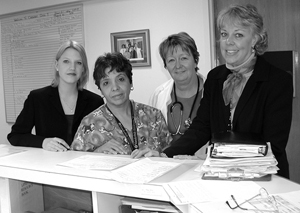
|
Social workers, doctors, nurses and other health professionals work together to assess
patient needs. Social workers Katherine Cone (left) and Patricia Prince (right) compare
notes on new patients with nurses Eve Padua and Ginny Warren.
|
Established in 1953, the Clinical Center's Social Work Department has provided critical services to patients and their families and staff to support both the research and clinical care that are part of NIH's mission. Thanks to innovative education, volunteer, language interpreting and HIV counseling programs, the department is now a world leader in medical social work.
"Social workers are integral members of the health-care team," said Dr. Adrienne Farrar, department chief. "They play a unique role in promoting and improving the emotional, social and spiritual well-being of the patient."
The department's goal, Farrar noted, is to empower patients and families by providing counseling, health education and community-referral services. "With a unique understanding of the diverse needs of research patients and families who come from all parts of the world," she said, "department staff members have always maintained values of caring and expert service. We have a rich legacy as patient advocates and leaders in medical social work programs."
That legacy of service and advocacy is focused on meeting the needs of patients and their families during extremely stressful and frightening situations.
"Social workers help patients and families cope with the emotional concerns of medical treatment. We work closely with Clinical Center physicians, nurses and other members of the health-care team," said Farrar.
Staff also help with the practical issues of receiving medical care far from home. "Staff can assist with travel and lodging and can help locate financial resources, from both within the NIH and in the community," she added.
When patients are ready to return home, social workers often assist patients and their families in locating resources in the local community and help them coordinate care at home.
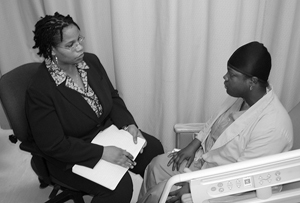
|
Social worker Ihsan Rogers counsels a patient. CC social workers provide services
for patients while they participate in trials and are a resource for help when patients
prepare to return home.
|
"Each patient, family, culture and medical condition brings a different experience," said social worker Patricia Prince. "The challenge we face is toassess each situation and appropriately bring patients and caregivers together at the right time to support both as needed."
Working with a diverse patient population is challenging, Prince said, but when life or death medical situations are involved, the cultural differences become even more complex.
The work is challenging but enormously gratifying. "The most rewarding part of my job is to work with patients who manage to thrive despite so many personal obstacles," added Ihsan Rogers, a CC social worker for five years.
"The Social Work Department promotes the mission of the Clinical Center through our contributions to the development and implementation of numerous initiatives, including the diversity program, the Safra Family Lodge and The Children's Inn," Farrar said. "For more than 50 years department members have published, presented and engaged in individual and collaborative research, both on national and international levels. Throughout our history, we have set standard of quality and excellence in patient care."
Social work services at the Clinical Center currently include such programs as:
Language Interpreters
The Social Work Department and its Volunteer Services Program have recently hired two language interpreters who speak five of the 40 most common languages. This cadre is supplemented by an active volunteer interpreter program that has recruited, trained and supervised hundreds of community and student volunteers to bridge the language gap between patients and caregivers. "The lives of countless patients and families have been enriched by staff and volunteers who provide language interpretation and other patient support services," said Farrar.
Human Subjects Protections
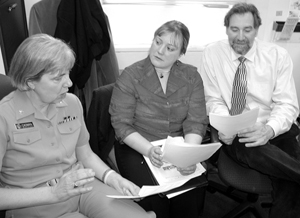
|
CC social worker Katherine Whorton (center) consults with NIMH nurses Mary
Ellen Cadman and Michael Pagliaro on patients being considered for participation in trials
sponsored by the National Institute of Mental Health. The three are members of NIMH’s the
Central Office for Recruitment and Evaluation (CORE).
|
Social worker Katherine Whorton is part of the National Institute of Mental Health's Central Office for Recruitment and Evaluation (CORE) team. She and her co-workers focus on protecting patients' rights by performing diagnostic screens of potential research volunteers, monitoring the informed consent process and assessing the capacity of vulnerable populations to participate in research.
"By making sure patients' rights are protected, we help research move forward," said Whorton. "Research volunteers often tell us that they appreciate the opportunity to contribute to furthering mental health research."
HIV Counseling
The HIV Counseling Program provides counseling, consultation, education and outreach about the human immunodeficiency virus (HIV), the virus that can cause the Acquired Immunodeficiency Disease Syndrome (AIDS). The HIV Counselor is available to discuss concerns, questions, feelings and provide education about HIV, and facilitate contact with community resources. Services are available for both patients and staff.
Want to know more about the Social Work Department and its volunteer programs? Call 301-496-2381.
100 years of social work in health care
March is Social Work Month, and the theme for this year's observance is "Social Workers. Help Starts Here." One goal of this year's campaign is to recognize the breadth and depth of the profession. The Clinical Center's own Social Work Department has roots that go back 100 years. Providing social work services in a health-care environment began at Massachusetts General Hospital in 1905 when the world's first hospital-based social work department was established. Its visionary founders social worker Ida Cannon and physician Richard Cabot believed hospital patients needed services, information and help for non-medical needs that affected their medical care. As Cannon said in 1930, "The medical social service movement recognized that there should be within the hospital someone definitely assigned to represent the patient's point of view…and to work out with the physician an adaptation of the medical treatment in the light of the patient's social condition."
Social work...did you know?
- Social workers are highly trained and experienced professionals. Only those who earned social work degrees at the bachelor's, master's or doctoral levels and completed a minimum number of hours in supervised field work are professional workers.
- Social work pioneer Jane Addams was one of the first women to receive a Nobel Peace Prize, which was awarded in 1931. Best known for establishing settlement houses in Chicago for immigrants in the early 1900s, Addams was a dedicated community organizer and peace activist.
- Professional social workers are found in every facet of community life in schools, hospitals, mental health clinics, senior centers, elected office, private practices, military installations, corporations and numerous agencies that serve individuals and families in need.
- Social workers help people overcome some of life's most difficult challenges. They help prevent crises and counsel individuals, families and communities to cope more effectively with the stresses of everyday life.
Back to Top
Acupuncture, Chinese medicine prove clinically successful

|
Dr. Adeline Xiao-Ying Ge deftly
inserts a needle into a patient’s hand. She
was instrumental in devising the electroacupuncture
regimen being used in a
National Center for Complementary and
Alternative Medicine study.
|
Grown men have been known to swoon at the mere sight of them and children cringe in terror, but to Dr. Adeline Xiao-Ying Ge, needles are the tools of her trade and part of the traditional Chinese medicine that goes back more than two millennia. Modern science uses varying sizes of needles to extract blood, take samples and administer vaccines and transfusions. Chinese doctors, however, use them to stimulate parts of the body, called acupoints, from the head literally to the toes, and with amazing success.
Ge brings her knowledge of Chinese medicine to NIH and the patients at the Clinical Center as part of the Rehabilitation Medicine Department. She also brings a medical degree and a two-year residency backed up with another medical degree integrating traditional Chinese and Western medicine. To supplement that, she has five years of advanced education in rehabilitation in t'ai chi and Qigong.
You could say it runs in the family. Ge is a proud descendent of China's greatest doctor and alchemist Ge Hong, of the Chin Dynasty (420 A.D.). A careful observer of nature in relation to medicine, Ge Hong provided detailed descriptions of smallpox, tuberculosis and other serious diseases that have plagued mankind. He wrote a number of books, one describing formulas for treating emergency medical situations (Handbook of Prescriptions for Emer-gencies) and Bao Puzi (Internal Treatise).
"Bao Puzi is still very useful to me in complementary medicine, clinical work and research with patients from the United States and other countries," Ge says. "In fact, we are using part of it for a new study now under way." Ge Hong, she adds, believed that the function of Qigong was to "cure diseases not yet contracted," a study known today as preventive medicine.
Why acupuncture works is open to debate. According to the ancients, the body's vital energy, qi (pronounced chee), circulates through interconnected meridians that regulate bodily organs and functions. Qi is energy and gong is skill, so the term Qigong refers to the skill in manipulating a person's life force and also is claimed to influence the flow of "vital energy." Although Ge has been taught from childhood the ancient Chinese beliefs and theories, she concentrates on the science of Chinese medicine and is convinced that acupuncture, herbal medicines, conventional medicines, and the attitude of those being treated are the crucial elements.

|
Patients can massage acupoints
such as the web between the thumb and
index finger to alleviate aches and pains as
well as headaches.
|
Dr. George Patrick, chief of the Recreation Therapy Section, Rehabil-itation Medicine Department, is an avid proponent of Ge and was instrumental in bringing her to the Clinical Center. "A gifted healer, Adeline not only reduces or removes unwanted symptoms, she often is able to cure certain illnesses and functional disorders. Acupuncture is only one of the modalities she uses, and she relates to our patients in a calm, soothing manner that conveys a confident optimism."
"Dr. Ge was instrumental in devising the electro-acupuncture regimen being used in the National Center for Comple-mentary and Alternative Medicine's ongoing study of electro-acupuncture for chemotherapy-induced delayed nausea and vomiting in patients with pediatric solid tumors," says Dr. Patrick
J. Mansky, who heads the oncology program, Laboratory of Clinical Investigation, NCCAM. "She also lent her expertise to the development of a multimedia training tool in the electro-acupuncture procedure and study mechanics being devised by NCCAM for the education of outside collaborators on this study."
Not only does Ge have numerous successes, an NIH study completed last year showed that acupuncture provides pain relief and improves function for people with osteoarthritis of the knee and serves as an effective complement to standard care. Funded by NCCAM and the National Institute of Arthritis and Musculoskeletal and Skin Diseases, the findings of the study the longest and largest randomized, controlled phase III clinical trial of acupuncture ever conducted were published in the December 21, 2004, issue of the Annals of Internal Medicine.
Back to Top
Brooklyn students learn about biomedical careers
|
|
|
About 25 students and staff members from the Arthur Ashe Academy based in Brooklyn, N.Y., were at the Clinical Center in February to learn more about careers in science and medicine. The visit included a tour of the new hospital and presentations on career development by NIH health professionals. The Arthur Ashe Academy is an after-school and weekend program for high schoolers interested in career opportunities in biomedical fields. In a collaboration with SUNY Downstate Medical Center, students also attend classes in anatomy and obtain hands-on lab experience.
|
Back to Top
The NIH Director's Wednesday Afternoon Lectures
The following is the schedule for the NIH Director's Wednesday Afternoon Lectures in March. Sessions are in the Clinical Center 's Masur Auditorium at 3 p.m., unless otherwise stated. For information or accommodations, call Hilda Madine at (301) 594-5595 (e-mail: hmadine@mail.nih.gov).
March 2
Weird Mammal Genomes and Sex
Jennifer A.M. Graves, Ph.D., FAA
Director, ARC Centre for Kangaroo Genomics; Head, Comparative Genomics Research Group, Research School of Biological Sciences, The Australian National University , Canberra
Host: The Genetics Interest Group
March 9
Organization and Function of the Synapse Proteome: A Cognitive Machine
Seth G.N. Grant, M.B., B.Surg.
Principal Investigator, Genes to Cognition Project, Wellcome Trust Sanger Institute, Hinxton, Cambridgeshire , UK
Hosts: The Structural Biology, Neurobiology and Proteomics Interest Groups
March 16
What is Human Stereopsis Good For?
Suzanne P. McKee, Ph.D.
Senior Scientist, Smith-Kettlewell Eye Research Institute, San Francisco
Host: The Integrative Neuroscience Interest Group
March 23
Quality Control of Transmembrane Proteins
Hugh R.B. Pelham, Ph.D.
Deputy Director and Head, Division of Cell Biology, Medical Research Council, Laboratory of Molecular Biology, Cambridge , UK
Host: The Cell Biology Interest Group
March 30
The NIH Director's Cultural Lecture Biotechnology and Nanotechnology: Two Overlapping Health Revolutions
Ray Kurzweil
Chairman and CEO, Kurzweil Technologies, Inc.; Inventor, Author and Futurist, North Andover , Mass.
Hosts: The NIBIB, Advanced Technologies Interest Group, and Office of the Director, NIH
Back to Top
| |
|
March 2005 Grand Rounds
12 noon –1pm, Lipsett Amphitheater
|
| March 2 |
|
The Neurobiology of Addiction: Insights from Neuroimaging
Nora D. Volkow, M.D.
Director, National Institute on Drug Abuse
Pharmacological Treatment of Alcohol Dependence: Target Symptoms and Target Molecules
Markus Heilig, M.D., Ph.D.
Clinical Director, National Institute on Alcohol Abuse and Alcoholism
|
| March 9 |
|
Contemporary Clinical Medicine: Great Teachers
Sexually Transmitted Diseases
King K. Holmes, M.D., Ph.D., Professor of Medicine,
Director, Center for AIDS and STD, University of Washington
Lecture can be accessed on the NIH videocast at http://videocast.nih.gov
|
| March 16 |
|
Graft-vs-Host Hematopoiesis: Definitive Therapy for Severe
Paroxysmal Nocturnal Hemoglobinuria and Aplastic Anemia
Richard W. Childs, M.D.
Senior Investigator, Tumor Immunology/Stem Cell Transplantation,
Hematology Branch, National Heart, Lung, and Blood Institute
The Platelet Membrane Receptor for the von Willebrand Factor and
Disorders of Hemostasis
Stephen G. Kaler, M.D., M.P.H.
Clinical Director, Intramural Research Program
Head, Unit on Pediatric Genetics, Laboratory of Clinical Genomics
National Institute of Child Health and Human Development
|
| March 23 |
|
Pilot Study of Proteasome Inhibitor Bortezomib and Re-irradiation for
Recurrent Head and Neck Cancer
Carter Van Waes, M.D., Ph.D.
Clinical Director and Chief, Head and Neck Surgery Branch
National Institute on Deafness and Other Communication Disorders
Head and Neck Cancer: Recent Advances and Future Directions
John C. Morris, M.D.
Investigator, Co-Director, Clinical Trials, Metabolism Branch, Center for
Cancer Research, National Cancer Institute
|
| March 30 |
|
Mastocytosis and Mutations in the KIT Receptor Gene
Dean D. Metcalfe, M.D.
Chief, Laboratory of Allergic Diseases
National Institute of Allergy and Infectious Diseases
Phospholipases, Eicosanoids and Inflammation
James H. Shelhamer, M.D.
Deputy Chief, Critical Care Medicine Department
National Institutes of Health Clinical Center
|
Visit the Clinical Center Grand Rounds Website at http://www.cc.nih.gov/about/news/grcurrent.shtml
|
Back to Top
|


 The information on this page is archived and provided for reference purposes only.
The information on this page is archived and provided for reference purposes only.